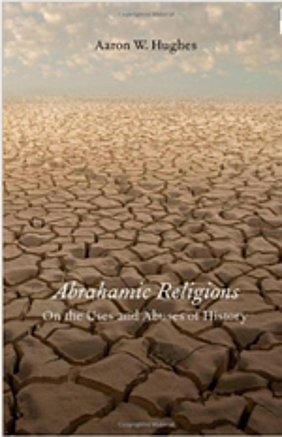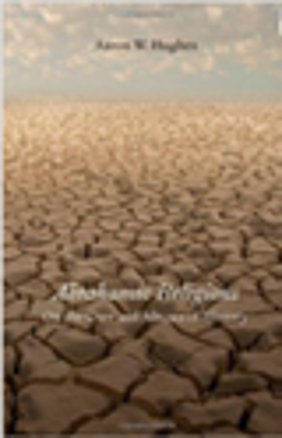Aaron Hughes’s recent book does not discover a new phenomenon, develop a new concept, or study a new field. Instead, Hughes subjects a phenomenon to critical scrutiny that has become all too natural and self-evident. At their best, such interrogations denaturalize the phenomenon to reveal layers of logical contradictions, ideological commitments, and uncritical assumptions that were hidden by its naturalization. Such is Hughes’s aim in his polemic against the proliferating proclivity and preference in both academic and nonacademic contexts for referring to Judaism, Christianity, and Islam as “Abrahamic religions.”
After an introduction to the project that specifies its central claims, Hughes offers a genealogy of the uses and abuses of the term “Abrahamic.” Prior to the mid-twentieth century, the term was used in interreligious polemics to imply that one religion--either Judaism, Christianity, or Islam, depending on the author’s perspective--was the rightful heir to the Abrahamic covenant. After the mid-twentieth century, the term came to stand for “a vaguely defined set of shared essential and phenomenological traits” (p. 35). For Hughes, both are deeply problematic.
Early followers of Jesus such as Paul look to the Abrahamic covenant as an anticipation of the kind of faith apart from the law that they were trying to define. Similarly, the Qur’an refers to the “religion of Abraham” as an originally pristine faith, corrupted by the later tradition and restored by Muhammad. Early Christians in the late antique period and into the Middle Ages developed an explicitly “anti-Ishmael” polemic that “sought to disable the claim that Muslims were the true descendants of Abraham” (p. 43). These Christian arguments were matched by polemics from Muslims who argued that Islam restored the original, pristine Abrahamic faith that Jews and Christians had corrupted. Hughes cites representative examples from various sources and time periods and finds none before the modern period that use the term to refer to shared commonalities or affinities among more than one religion. Instead it was used to exclude other religions and to legitimate one on the basis of Abrahamic (in)authenticity.
References to Abraham and Abrahamic religions decisively shifted from exclusion to embrace in the mid-twentieth century. No longer a marker of distinction, Abraham began to symbolize a bond among Judaism, Christianity, and Islam. In the aftermath of the Second World War, the Holocaust, the Arab-Israeli wars that ensued after the creation of the State of Israel, and the unrest created by North African countries achieving independence from European colonial powers, Abraham became an important sign of the possibility of healing and peace among diverse peoples and religions. Primarily as a result of efforts by Muslims or scholars of Islam, “Abrahamic” arose in places where previously one would have been more likely to find the less inclusive term “Judeo-Christian.” Vatican II, for example, used Abraham to articulate the church’s sense of commonality with other traditions. After the events of September 11, 2001, Abraham became primarily a sign of peace and hope in response to religious militancy. In the context of interfaith relations where references to “Abrahamic religions” often occur, the term is used to signify shared histories, beliefs, and practices among Judaism, Christianity, and Islam that distinguish them from other, “non-Abrahamic” religions. The list of shared characteristics often includes, for example, faith, monotheism, covenant, ethical responsibility, and eschatological judgment.
Hughes laments that the category “Abrahamic” “forces an artificial order on three radically different traditions” (p. 80). Such abstract categories, he contends, “actually tend to obscure our understanding of the data in question by leveling complexity.... Commonalities are perceived in abstract theological categories, not historical specifics.... Such statements are essentially meaningless.... The results are extremely general and vague” (p. 81). Hughes rejects “Abrahamic” as an essentially empty signifier, capable of being filled with whatever content is deemed convenient to the one who deploys it, and so unsuitable for and even inimical to critical, historical analysis.
Hughes recognizes that “the comparative enterprise is predicated on distortion,” but the distortion caused by the category “Abrahamic” “threatens to impede understanding” (p. 91). As Hughes notes, it is not unique: “many of the terms and categories that we are fond of employing are little more than untheorized folk taxa (e.g., religion, the ‘sacred’)” (p. 103). Like other terms, such as “prayer,” “liturgy,” and “myth,” “Abrahamic religions” is critically suspect because it conflates various diverse phenomena and distorts our ability to grasp what it purports to name. Coupled with its ideological roots, motivation, and content, the flight from historical complexity enabled by the term “Abrahamic religions” renders it unredeemable for Hughes.
According to liberal doxa, the mid-twentieth-century shift in the use of “Abraham” represents a more honest appreciation of the interconnectedness among three obviously related traditions. For Hughes, however, the current interfaith use of the term is no less problematic than previous, supersessionist uses. Hughes’s book thus participates in the burgeoning efforts by such recent historians as Talal Asad and Tomoko Masuzawa to uncover the ideological underpinnings of liberal religious concepts that are presented and lauded as exemplary of an enlightened, secular, objective, and pluralistic critical perspective. However, Hughes’s central concern with the use of the term “Abrahamic religions” is not with its covert preservation of European universalism. While he briefly mentions this ideological danger in several places (e.g., pp. 77-79, 91, 100-101), it is unfortunately undeveloped. Instead, Hughes’s objections stem almost exclusively from his conviction that the term facilitates and even enables--in the words of his subtitle--“abuses of history.” The term conjures the idea of a basic, unchanging, essential core, shared by three distinct traditions, which renders one blind to the complexity and diversity that appear at any glance into the historical archive. The ever-increasing uses of the category perpetuate and are often motivated by a covert and even overt liberal agenda aimed at enabling peaceful coexistence among adherents of these three traditions. In short, Hughes uncovers the ideological abuses to critical historical research enabled by a category that is increasingly used in scholarship to advance certain values.
Readers, however, face an unresolved tension. Hughes’s arguments are often provocative, substantive, informative, and successful in their identification of the essentializing dangers and ideological values brought by references to “Abrahamic religions.” Yet these arguments are framed within the distinctively European binary--deconstructed by Asad, Masuzawa, and others whom Hughes cites--that cordons off the theological/sacred as the sphere of ahistorical and ideological values that can be and must remain completely separate from objective, historical research. Hughes presents the use of “Abrahamic religions” as “a case study of the slippage that can occur between Theology and Religious Studies. We must resist using the former as if it were a simple extension of the latter and vice versa. Unless we do so, unwarranted value judgments potentially enter the analysis” (p. 144). Hughes’s arguments would have benefited from either a different framework or a more theoretically sophisticated discussion of how his framework avoids what others (whom he discusses) have uncovered about the secular–sacred binary--i.e., that it can be as much of an ideological Trojan horse as he reveals the Abrahamic–non-Abrahamic binary to be.[1]
This tension may be symptomatic of a deeper limit to Hughes’s proposal. His main frustration is with generalizations (e.g., Judaism) and meta-generalizations (e.g., Abrahamic religions) that operate on a conceptual model that posits some essence to the generalized term that the historian can then identify and trace through various particular, developing manifestations. “Abrahamic religions,” however, has no essence either in the identity of Abraham or in the substance of the three traditions. Whatever one posits as the essential traits of Abrahamic religions are either too vague to be helpful or unfairly exclusive of subgroups that do not share those traits. The term’s current popularity is driven solely by pluralistic politics and ecumenical ethics. Hughes therefore advocates rejecting the term and its accompanying conceptual model in favor of approaching social relations in their local specificity and unique particularity with a conception of complexity and diversity. This conception would allow historians to recognize and map the overlapping, intersecting, and implicating characteristics that are distributed throughout social relations. “The result is complexity. Real complexity based on shared traits of overlapping subgroups that comprise each ‘religion’ ... [and not] three discrete ‘Abrahamic religions’ interacting with one another” (p. 140). While this model rightly shifts its conception of identities from essences to historical and social constructions, it continues to understand identity as something that emerges and functions in opposition to other social identities.
Are differences best understood as reflections of complex, diverse, and pluralistic identities? This conception predisposes one to approach identity through analytic specification that, no matter how hybrid, ultimately leads to the isolation of disconnected designations. Would we not benefit from a conception of identity and difference that could better account for all of the following: the uniqueness of subject positions in any historical moment, the cohesion that connects necessarily different positions, and the capacity of identities to differ from themselves (and not just from others)? If, as in the thought of someone such as Gilles Deleuze, we can conceive of difference as the primary term, an active process that generates further difference (and not a passive representation dependent on identity), then “Abrahamic” might just emerge from the grave to which Hughes sends it since, as his analysis clearly demonstrates, what Abraham is in history and tradition is an operator of difference by which one group differentiates itself into subgroups that continue to self-differentiate. The God who addresses Moses is the God of Abraham (Exod 3:6). Abraham operates in the variations from which the Jesus movement and rabbinic Judaism emerge, as seen in the changing interpretations of him in the Oral Torah and New Testament. Abraham is an operator of self-differentiation in early Christianities; James’s representation of Abraham precisely inverts Paul’s (cf., Rom 4:1-5 and Jas 2:21-26). And, Hughes argues, Islam similarly emerges as a type of (Arab-)Judaism. Although these uses of Abraham have no consistent or historical identity, Abraham has consistently functioned as an operator of historical differentiation. In this capacity Abraham may just resist every attempt to represent him as eliminable.



